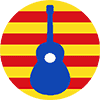History of Rumba Catalana
6. 1975 : Death of a Dictator, Catalan Rumba Gets Into Trouble
With the Death of the Dictator Franco, the Catalan Rumba is in the Dock
Gypsies get caught in the wake of a cultural backlash
From the death of the Caudillo in 1975, the intelligentsia of the left condemned the copla, a musical genre derived from Andalusian folklore, for being “the soundtrack of Francoism“, “frivolous“, “reactionary” and “decadent“.
The Catalan rumba was also targeted, with the same arguments and a certain indifference towards the fate of the Gypsies under Franco. They had not been politicized, nor had they been militant against Franco. Instead, said the accusers, they had produced “regressive” music for the masses with the blessing of the regime. The contempt had passed to the left.
The inventor of the genre, El Pescailla, and his wife Lola Flores – who had also been the ambassador of the copla – had been regularly invited by the Franco couple and were singled out. Many other Gypsy rumba artists suffered the same fate, accused of having contributed to “nacional-flamenquismo“. Even Peret did not escape critics, having been in 1974 the official representative of Spain in the Eurovision Song Contest.
The amalgam was cruel, since for forty years the Spanish Gypsies had been the victims of a regime that had never ceased to convey the traditional stereotypes attached to Gypsies in order to transform them into a social counter-model, while at the same time exploiting the image of the Gypsy folklore and popular Gypsy artists – who had little choice but to comply with it – as part of a policy of tourism promotion. There was, of course, almost no reference to Gypsies. Music and dances were presented as Spanish, socially, formally and ethnically bleached.
In the second half of the 1970s, Catalan rumba was losing ground. It was the time when, ignored on all sides, many Spanish Gypsies turned to the evangelical church. Many musicians hung up their hats, like Peret, who became a pastor.
Galvanized by the wind of freedom blowing through Spain, a large part of the Spanish youth turned away from the genre, which had become outdated in their eyes, associated with Spanishist tackiness and a past to be forgotten.
Why the Evangelical Church?
Pope Pius XII had declared Franco’s Spain to be “God’s chosen country” and the Spanish clergy was a faithful ally of Franco’s for 40 years. In spite of their historical Catholic faith, the Spanish Gypsies were hardly considered by the Catholic Church during this period.
The evangelists of the church of Filadelfia, of Protestant denomination and Pentecostal current, founded by El hermano Emiliano, a Rom pastor, grew strongly after the death of Franco, welcoming those flocks in need of recognition, abandoned by the church.
El hermano Emiliano had been trained in France by the Breton Pentecostal pastor Clément Le Cossec, founder of the Evangelical Mission of the Gypsies of France – Vie et Lumière, benefactor of the Gypsy community, to whom he dedicated his life.
IN THE NEXT CHAPTER :
Catalan rumba was saved from oblivion by an Argentinean immigrant, Gato Pérez, who embodied the rebirth of rumba Catalana in the post-Franco era. He was actually the first to call the genre “rumba Catalana“, forever strengthening its cultural identity.

